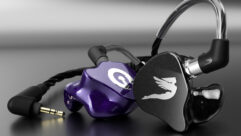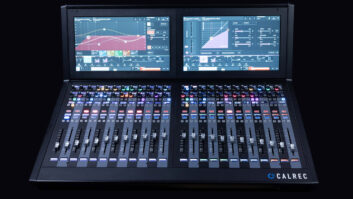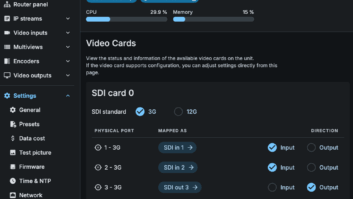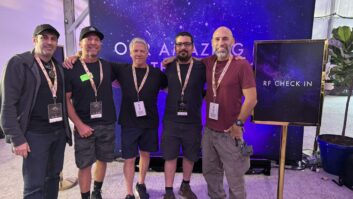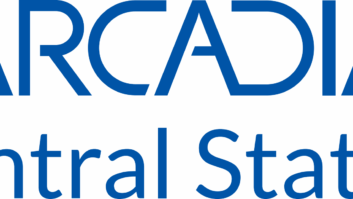A Taste of Florida
Jun 1, 2002 12:00 PM,
BY CHRISTOPHER BUTTNER
At exactly 2:02 p.m. on Feb. 2, 2002, the Gaylord Entertainment Company celebrated the opening of the $450 million Gaylord Palms Resort and Convention Center near Orlando, Florida. The series of twos in the date and time of the grand opening are not coincidental: The Gaylord Palms is the second resort construction project by parent company Gaylord Entertainment as it expands its national chain of convention resorts. The first resort, The Gaylord Opryland Resort and Convention Center in Nashville (formerly The Opryland Hotel) opened in 1996 and hosted the NSCA Expo in April 1999.
THE GRAND TOUR
situated on 63 acres, the architecture of Gaylord Palms is that of a grand 19th-century Florida seaside resort, except with 1406 rooms covering 2.1 million square feet. The 4.5 acres of glass atriums, maintained at a comfortable year-round 68-72 degrees, shelter themed Florida environments reflecting the architecture, natural resources, beauty and personality of Key West, St. Augustine and the Everglades. The St. Augustine atrium features a reproduction of Castillo de San Marcos, the oldest Spanish fort in North America. At the Key West atrium, the 60-foot S.S. Gaylord (cocktail and raw bar) is moored in a 161,000-gallon coral reef harbor. The Everglades atrium features ground fog, streams and lush vegetation.
At the heart of the Gaylord Palms is the Emerald Bay, a separate 362-room boutique hotel within a hotel, featuring upscale guest rooms and suites, additional services and embellished meeting rooms and facilities.
“It’s unusual for a hotel to be so elaborately and deeply themed,” said John Caparella, senior vice president and general manager of the Gaylord Palms. “Everything in the hotel, down to the ice buckets, evokes a Florida theme.”
The Gaylord Palms is the first resort in Central Florida to focus entirely on the meetings and convention market. It is designed to accommodate groups from 10 to 10,000. The 400,000-square-foot convention center features Florida’s largest hotel-based exhibition hall (at 178,000 square feet) and second largest hotel ballroom. Forty-six of the 61 breakout rooms are located between the 28,690-square-foot Sun Ballroom and the 46,650-square-foot Osceola Ballroom. The Osceola Ballroom features a fully functional theatrical stage that’s 40 feet deep and 100 feet wide, topped by a 50-foot-high proscenium that is equipped for a keynote speaker or a complex musical production.
AN EXPERT TEAM
martin schaffel, president and CEO of Audio Visual Innovations Inc., founded the company in 1979, in Lakeland, Florida, and has grown the company into a national leader in the field of full-service audiovisual presentation technologies. Headquartered in Tampa, the company employs more than 350 seasoned professionals who service corporate, educational, military and government accounts from regional offices in Ft. Lauderdale, Jacksonville, Orlando, Tallahassee, Atlanta, Dallas, Los Angeles, Virginia Beach, Chicago and Washington, D.C.
The fastest growing segment of AVI is the Systems Integration group. This group provides custom design and installation of presentation systems for facilities such as network operation centers, government commission chambers, boardrooms, meeting rooms, computer classrooms and distance learning facilities.
AVI was given the vast responsibility of installing the audio/video/network and cable infrastructure for the entire Gaylord Palms facility. A Peavey MediaMatrix backbone handles all audio routing over an audio network that consists of a million feet of cable, 2466 speakers in 398 zones, 568 plate locations and 114 audio, video and fiber patch panels located in 75 equipment racks.
When lead technician/programmer Scott Ferguson joined AVI in April 2001, the company gained his 20 years of hotel, convention center and corporate audiovisual experience and 17 years in computer networking, systems integration, programming and Cisco Academy training.
Joe Kurta, systems integration specialist, joined the Peavey MediaMatrix Design Services division in early 2000, after spending several years as an audio design specialist at Walt Disney World in Florida. A seasoned systems integration veteran at only 27 years old, Kurta has been a part of installing more than 100 MediaMatrix systems over the course of his career. Joining Disney directly out of college, Kurta was reluctant to learn the MediaMatrix at first. “One day my boss sat me down in front of a computer, gave me the manual and said, ‘You need to become the expert on this,’” Kurta said. “Several months later we installed two cruise ships and a theme park jam-packed with MediaMatrix systems. In retrospect, learning Mware was relatively intuitive, but it would have been a lot easier to enroll in the class. I lived and breathed MediaMatrix for about a year straight, so making the jump to Peavey made sense.” Kurta is Peavey’s primary instructor of both MediaMatrix Fundamentals and Advanced MediaMatrix classes.
While working on several other projects simultaneously, Ferguson programmed the Gaylord Palms MediaMatrix system over the course of three months.” Scott had e-mailed me many of the Gaylord Palms MediaMatrix files, and it was apparent he had put a lot of time into the project,” Kurta said. “After careful review of his work, and not being able to find much to improve upon, I got maybe one or two additional phone calls from him as the system continued to be developed. The Gaylord Palms was a complicated MediaMatrix installation and AVI should be commended for its meticulous programming abilities and also for how smoothly the installation went.”
AN INTEGRATED SYSTEM
the heart of the MediaMatrix system, running MWare V3.2, consists of five Mainframe 980nts that control the massive convention center side of the hotel. One Mainframe 980nt controls the hotel side of the resort, and two MediaMatrix Miniframe 208nts are used for the spa and the two main boardrooms. Saving the hotel significant labor and material expenses, Peak Audio’s CobraNet was used to handle all audio routing to amplifier rooms.
Gaylord Palms receives 12 channels of 24/7 background music off of a single one-meter satellite dish, two Sony DVPS560 DVD players, four Tascam CD-305 CD changers, two Tascam CD-A700 CD/cassette players and one Arrakis Systems DC6-1000 six-output, rackmounted, hard-drive playback system, capable of 35 hours of audio playback. The Arrakis hard drive is installed into the satellite feed with a “ducker” as a back-up device. “In case the weather ever obstructs the satellite feed, the customer-provided music on the Arrakis comes on in a matter of seconds, picking up six random tracks customized for the various themed zones,” Ferguson said.
Audio from the DVD and VCR players is routed from the 208nt MediaMatrix system to either of the main executive boardrooms, both of which are capable of surround sound. Video is routed through Autopatch 8×8, 16×16 and 32×32 video routers throughout the complex, including the Panasonic PT-L797PXUL rear projector in the Hemingway Boardroom.
“The design criteria called for a routing system with the ability to plug a microphone in to any mic jack in the resort and distribute that signal to any zone, or set of zones, anywhere in the facility,” Ferguson said. “The beauty of MediaMatrix network technology is that we were able to quickly design such a system in which the user had complete control to put audio anywhere.”
The front-end of the system consists of 83 Crestron control panels. That’s 69 LC1000 MiniTouch panels installed in the convention center breakout rooms, six 10-inch monotone LC3000L panels, five CT1600 color portable panels, two CT3500L color active panels and one TPS4500LB 10-inch color active panel. Five Peavey CobraNet Audio Bridge 16is, thirteen CAB 16os, nine CAB 8is and one CAB 8o distribute digital audio between the control rooms and the amp rooms. Nineteen QSC RAVE188s digital audio distribution interface units are used to move the digital audio signal between the IDF rooms (the smaller, shared audio and data rooms) and the main audio control rooms.
▪ Audio, Amplification and Control. Loudspeakers from Renkus-Heinz, Tannoy, OWI, Technomad, Community and JBL installed throughout the hotel, atriums and convention center are driven by 236 Crest CKS and CKV series amplifiers. Controlled from four main control centers and 17 substations, the system allows the digital and analog audio signals to be routed and rerouted from any one of the 83 Crestron control touch panels. The entire system can be tested and monitored by a single operator, and it’s also interfaced with the Crest NexSys digital control systems.
The Crest amplifiers use a range of interface modules to adapt them to different operational designs. In addition to the 18 NDP-ENG Ethernet gateway interfaces, the CKV and CKS amplifiers were fitted with Crest’s DSPA digital signal processing module, the NXS NexSys interface module and the SLM systems module. As a result, every one of the 236 amplifiers in the system are able to be load-tested, performance-tested and configured from a single control panel by a single operator in a matter of minutes. It might otherwise take hours to test or reconfigure each element of the system.
“By using the NexSys for the fine-tune control of the audio as it’s being processed through the amplifiers, the MediaMatrix is able to be dedicated to the task of routing and mixing the audio,” Ferguson said. “Therefore, the MediaMatrix does the gross controlling of a zone while the NexSys controls individual amplifiers within the zone. The NexSys software is running independently of the MediaMatrix system on a standalone Dell Precision 330 computer, which can be wheeled between multiple control stations but is primarily housed at the head end of the system. We have one primary head-end and two secondary head-ends of the network with MediaMatrix frames in seven locations.
“MediaMatrix offers complete control of the NexSys program,” Ferguson said, “but I wanted to keep it in one central location with one point of control instead of putting control into several MediaMatrix control interfaces that could open up opportunities for problems to hatch.”
CREATING THE SCENE
a set-and-forget aspect of the NexSys system is found at the Key West Atrium, which consists of many small zones, each using loudspeakers of various sizes. Throughout the Gaylord Palms, MediaMatrix is set flat while NexSys digital signal processing assures transitional and transparent smoothness eliminating dead areas and hot spots between zones. The uniformity of the program material and environmental sounds of the Key West boardwalk plays a critical role in the realism of the design theme.
The effect is as though the visitor were at a harbor where uninterrupted sounds of the port’s activity, sea swells, ships, seagulls and wind are all around. Depending where the visitor walks on the Key West Boardwalk, each zone is configured to best represent the program material in proximity to the subject, thereby assuring a realistic environmental effect.
The hotel also makes use of an often-overlooked feature of Media Matrix: event scheduling. Using the scheduler, the hotel is able to allow music to cue up or change routing paths based on the time of day. That is handy for the parade-like caravan that wends its way through the atrium during the day. At the scheduled interval, the MediaMatrix scheduling function automatically cues up and routes the music to the correct zone for the event.
The Gaylord Palm Resort Spa, within the hotel’s main atrium, has its own 208nt Miniframe and consists of 28 independent zones. Those zones include the small massage, facial, and water therapy rooms and the main fitness and workout rooms. Each room is locally controlled through a Crestron control panel. Using the panel the therapist or trainer can chose from as many as 12 satellite audio channels by selecting the BGM source or pick from four extra CD and DVD sources. All of that uses only a fraction of the 208’s power.
▪ Convention Center Ballrooms. MediaMatrix and NexSys combine to quickly reconfigure the audio routing and DSP of sound systems in the 28,690-square-foot Sun Ballroom and the 46,650-square-foot Osceola Ballroom. “With Dave Marsh of Pelton Marsh Kinsella (the design consultant on the project), we tweaked the audio to establish the parameters using a TEF 20,” Ferguson said. “First, I installed a 10-band EQ in the MediaMatrix for the Crest amps driving the Tannoy ceiling speakers. We then sampled and averaged the pink noise until we narrowed down the parameters to five bands. We then put that EQ setting into the amp using the five-band parametric within the NexSys DSP to flatten the room.”
Both ballrooms are capable of being subdivided. The Osceola Ballroom can be separated into 15 rooms and corridors. When the Sun and Osceola Ballrooms and the 12 City Hall meeting rooms are divided for smaller events, the audio for audio routing and controls are reconfigured at the Crestron panel for the smaller rooms. Each room has a Crestron LC-1000 touch panel with controls for master volume, mic and line levels, background music choice and level and room link/unlinking control. Each of the controls is contained on three levels of password protection, which allows different levels of training and access for users.
“With control panels in the rooms and the MediaMatrix interfaced with the NexSys, the hotel staff can quickly reconfigure the rooms for events, with the audio routing and signal processing parameter reconfigurations being the least time-consuming aspect of the job,” Ferguson said.
The Osceola Ballroom’s default setup is as a performance room. In this setting all the internal walls are collapsed and stored, and the individual rooms are combined into one large performance hall. For an onstage performance, the FOH sound system is brought in as needed, usually by the in-house A/V company. The sound company does not have to add and configure additional delay speakers to the room: They are already built into the ceiling and configured into the system.
When the Osceola is in a combined state, the 100 Tannoy CMS12-8 ceiling loudspeakers in 50 zones, driven by the 25 Crest CKS-800 amps, are configured into seven delay rings. After the FOH system is plugged in to the system, with one press of a button the Crest NexSys program reconfigures and adjusts the amp DSPs. The Tannoy’s output is reconfigured from speech support to a delay ring configuration for FOH support, which distributes a more uniform sound as far as 200 feet from the stage, across the massive 46,650-square-foot ballroom. That enables a smaller, lower profile FOH sound system to be used for stage events, eliminating a hot stage output that could overwhelm the audience members closest to the stage and negating the need for a costly set of delay speakers. Small and medium-size groups have the ability to enjoy a big, impressive sound on a smaller budget.
“The goal was a flat, properly delayed system,” Ferguson said. “The soundperson simply inserts his or her additional EQ and effects for the FOH system at the mix position. Any FOH person is going to want to touch and feel the signal processing, as opposed to using settings that have been predetermined behind the scenes.”
SMOOTH WEATHER
“generally, when I show up on a project, there are still a lot of workers running around asking, ‘Why aren’t certain aspects of the system working?’” Kurta said. “I didn’t see any of that on the Gaylord Palms project. When I came into the project to offer some network design assistance, I found the system to be very sound. I don’t think I ever saw anyone working on the network, other than Scott [Ferguson] reprogramming a couple of VLANs every once in a while. Scott made it do exactly what it was supposed to do. That’s very good, because it made the network completely transparent, and a network is supposed to be transparent.”
For Ferguson, the Gaylord Palms was an exciting MediaMatrix project. “It combined all aspects of my experience — computer networking, data cabling (both fiber and copper), the hotel/convention AV business and management skills,” he said. “[It was] a perfect fit for AVI.
Christopher Buttner is a freelance journalist serving various entertainment technology manufacturing industries including audio, video, lighting, staging and multimedia systems integration. Contact him at[email protected].
VLANS: Keeping It Organized
One of the hurdles Ferguson encountered was keeping track of where all of the network audio channels were going. “In a network this size, you need to separate the network into VLANs,” he said. “That allows more control over the bandwidth utilization and moves the audio signals into smaller, more easily managed network segments.
“We used 7 VLANs for the Gaylord project and three of them for CobraNet transport. VLAN 1 is designated for Cisco administration, VLAN 10 is for two Cat-5 jacks, which are located on the front of the racks for possible future use of video over IP. VLAN 20 is for the control communications of the Crest NexSys, Crestron Crestnet and Peavey control. VLAN 30, 35 and 40 are used for CobraNet. VLAN 50 is open, ready to go, but unused.
“Creating a trucked VLAN takes several, time-consuming steps. By preconfiguring the Cisco switchers in the shop with that additional VLAN, all that is required now is to configure the individual ports that are needed, with little additional overhead. We divided the hotel and the convention center Peavey CobraNets into two separate VLANS, with a gateway between the two segments through one of the MediaMatrix units. We also put the RAVE188s on their own VLAN, to limit any conflicts between the already busy Peavey and QSC VLANs on the convention center side. We used a spreadsheet to document every VLAN and every IP used on the network. That helped keep track of the network as equipment was brought online.”
For More Information
Arrakis Systems
arrakis-systems.com
□ 200
Audio Visual Innovations Inc.
aviinc.com
□ 201
Autopatch
autopatch.com
□ 202
Cisco
cisco.com
□ 203
Community
loudspeakers.net
□ 204
Crest
crestaudio.com
□ 205
Crestron
crestron.com
□ 206
Dell
dell.com
□ 207
Goldline/TEF
gold-line.com
□ 208
JBL
jblpro.com
□ 209
OWI
owi-inc.com
□ 210
Panasonic
panasonic.com
□ 211
Peak Audio (CobraNet)
peakaudio.com
□ 212
Peavey (MediaMatrix)
peavey.com
□ 213
Pelton Marsh Kinsella
pmkconsultants.com
□ 214
QSC
qscaudio.com
□ 215
Renkus-Heinz
renkus-heinz.com
□ 216
Sony
sony.com
□ 217
Tannoy
tannoy.com
□ 218
Tascam
tascam.com
□ 219
Technomad
technomad.com
□ 220
□=Circle this number on Reader Service Card for more information.


